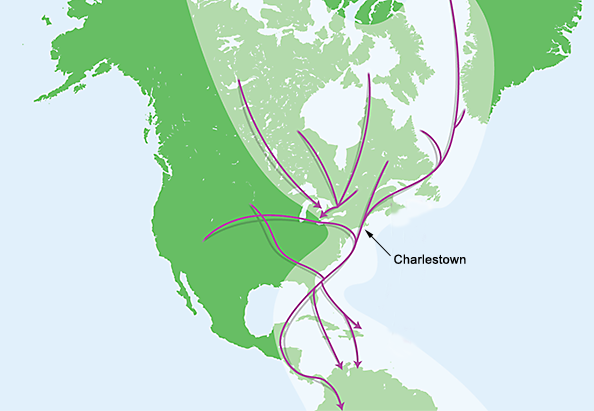See Live Bird Migrations Through South County
In Charlestown, the fall bird migration begins in August and continues into November. The map below shows routes for the fall migration in the Atlantic Flyway. One of the main routes, for both the north and south migrations, passes through southern Rhode Island.

Birds are tracked on radar and thousands of birds are passing through Washington County each night. Click on the first blue bar below to see the current counts for Washington County.
Birds In Flight Over Washington County
You can see real-time analysis maps of intensities of actual nocturnal bird migration, as detected by the US weather surveillance radar network between local sunset to sunrise. Not every night is a busy migration event over Rhode Island. It depends quite a lot on weather conditions in more northern areas of New England. Cornell Lab of Ornithology currently produces these maps. Click on the next blue bar to see a video of these maps and choose different dates to see different bird migration traffic.
Live Bird Migration Video
Want to help birds as they make their long journeys? Here are a few tips from the Audubon Society of Rhode Island:
- Lights out! Many migratory birds fly at night and the lights from buildings can confuse them, leading to unsuccessful migrations due to exhaustion and even death. Turning out the lights is beneficial for the health of other wildlife too, plus you will be conserving energy.
- Window collisions are one of the top threats to both migratory and resident birds. Window tape or decals are an easy way to make sure your windows are bird-safe. Specific bird-safe window designs that can be used in urban planning can also help address this threat.
- Keep your cats indoors or carefully supervised on a lead. Cats are domesticated animals, making them the greatest source of human-caused mortality for birds and mammals
- Go easy on the yard work and select native species of plants for your yard and garden. Every yard, park, school ground, and natural areas around businesses can act as stopping points for migratory birds, providing much-needed sources of refuge and food! A “messy” yard with native plant species encourages biodiversity which is good for birds and all life.
- Pesticides are dangerous for birds and wildlife – limit their use. If they are needed, follow the instructions carefully.
- Keep bird feeders and water sources well-stocked and clean! Provide a variety of seed options for different bird species. Clean your equipment every two weeks: scrub with warm, soapy water then soak in a 10% bleach solution, rinse well, and allow them to air-dry completely. If black bears have not yet entered hibernation hold off on filling seed feeders.
You can learn more about tools that predict and monitor bird migration at BirdCast.